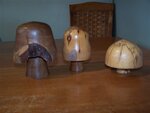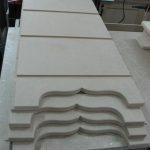We may receive a commission when you use our affiliate links. However, this does not impact our recommendations.

The hardest thing about dovetailing isn’t the sawing or the chiseling or the layout.
It’s the seeing.
I don’t think I can teach anyone to see, but I can show you where to look. Developing your eye , plus your ability to sense the perpendicular , will do more for your dovetailing skills than any jig, square, knife or saw.
Like everything with dovetailing, it all begins at the baseline , the thin scratch across the grain that determines the limits of the joint. When you remove the waste between the tails and the pins, a frequent error is to leave too much material behind, which prevents the joint from closing.
You need to be able to glance at the joint and sense immediately if the baselines on the front and back of your workpiece line up without any waste between them. Ian Kirby and other woodworking instructors recommend using a small square to probe the joint and look for humps and bumps.
I have never had much luck with the small square approach. If I have to probe a joint, I’ll do it with the long side of a chisel and see if the tool rocks back and forth on anything. Then I use the same chisel to tease out the garbage.
But it’s rare that I ever do that. Instead, I hold the board up to eye level and take a quick look. After enough dovetails, you’ll see it and know exactly what to do.
And the truth is, I rarely have to do much to my baselines except chase some little bits of junk in the corners. And that’s because I have a good sense of the perpendicular. We’re all born with it, but it’s like a muscle. You need to work at it.
When I’m chiseling out the waste between my tails and pins I hold the chisel at 90° to the work and stand to the side of the tool to ensure it’s at 90°. Again, other woodworking authors recommend you use a square or even a block of wood clamped to your baseline as a reminder. But this is really a “Use the Force Luke” moment. You know 90°. Just position yourself so you can see it.
(Quick side note: The more hand work you do, the more you’ll find this comes in handy for boring and mortising especially.)
The other time this sense of 90° comes in handy is when you are sawing your pins out and the waste blocks on the ends of your tail boards. A pencil line or knife line is handy, but the real guide is your gut. You’ll know when things are going wrong, even if the line is covered in dust.
Once you start developing these two skills you’ll find that you can put your winding sticks away when processing boards with your handplanes. Your sense of square will show you the high spots in a board at a glance.
This blog post is not brought to you by the High Times beauty pageant. Promise.
– Christopher Schwarz
You may also be interested in the “Mastering Hand Tools” DVD from Christopher Schwarz.
Here are some supplies and tools we find essential in our everyday work around the shop. We may receive a commission from sales referred by our links; however, we have carefully selected these products for their usefulness and quality.










Adam,
Try holding the chisel like a pencil and resting your hand on the work (I should post another photo). That makes it very easy to hold and adjust the chisel. And when you see 90°, hit the chisel.
This is why I like lightweight chisel for dovetails. Top-heavy chisels are fatiguing.
Chris
Aha, that’s what I thought. Thanks for the picture, your team always puts really good pictures up. I like that about your magazine, too.
I think one can be trained to SEE 90deg pretty well. But from my experience dating back to pre-kindergarten days in Dad’s shop, it’s a whole other ball of wax to be able to HOLD 90 degrees…do you know what I mean?
Heck, holding any angle for that matter. I did a lot of work with balsa wood and sand paper, carving model aeroplane propellers, shaping trailing edges of wing airfoils, using nothing but a sharp leather knife, and a block of wood with some sand paper gripped around it; that was quite a high art for a 5 year old under Dad’s unwavering sense of perfection!
Anyway, How one holds a chisel still while swinging and striking it with the mallet…those things have always been the harder part in all this for me. I guess that’s why I clamp a fairly square edged block of wood down over the workpiece so that I have a tactile reference to push my pedestrian chisels up against. Someday I might figure out how to hold the chisel orthogonally with from my work piece while using the Force…
All this talk is obviated with experience as you say…wanna get good at dovetails? just do a couple hundred thousand…I hear ya, my man.
Anyway, thanks for following up with the photo and keep the good writing and good photographic content coming on your blog; it’s good stuff.
Adam
Adam,
Good question. I’ve added a photo above in the blog post that helps illustrate this. You want to stand so you can see the chisel from its long side.
Some people orient the work so they are facing the bevel. Then you can’t see if you are at 90°.
Hope this helps.
Chris
I’m at the point where I’m just starting to see these things. It’s been about one year since I started cutting dovetails by hand (mostly in scraps) and I just recently built a small box with them. Not the greatest fitting dovetails, but there’s only two major gaps and they were from cutting on the wrong side of the line. Ooops. But, after all the practice I’m beginning to see where things need to be touched up. Great post.
Hi Chris, thanks for the april 20 reference 🙂
I wonder if you could explain what you mean by "standing to the side of" the chisel? is the piece you’re working on oriented towards you or are you standing along side the work? A picture would be handy…
hee-hee….
Yeah, I too sometimes have a (ahem) ‘sense of enlightened or hightened -body- awareness’ being able to easily see that ‘perfect perpendicular’…it’s usually right after I spark up a…I mean…practice my hand tool skills. ??@#$%
Nice joint…er….link.
I understand this whole concept. I too have an excellent sense of the perpendicular. It is too bad that so many believe that they can’t saw straight or hold a chisel square or perform any other rudemntary task with out a jig. Or bodies are complex instruments able to detect the slightess variences, all we need to do is embrace it.